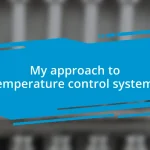Key takeaways:
- Thermocouples are vital in various industries for precise temperature monitoring, impacting processes such as baking, chemical reactions, and food safety.
- Understanding and selecting the appropriate type of thermocouple for specific applications is crucial for accuracy and reliability; Types K, J, T, E, and N cater to different temperature ranges and environments.
- Regular maintenance, calibration, and educating team members on best practices are essential for the optimal performance and longevity of thermocouples in industrial settings.
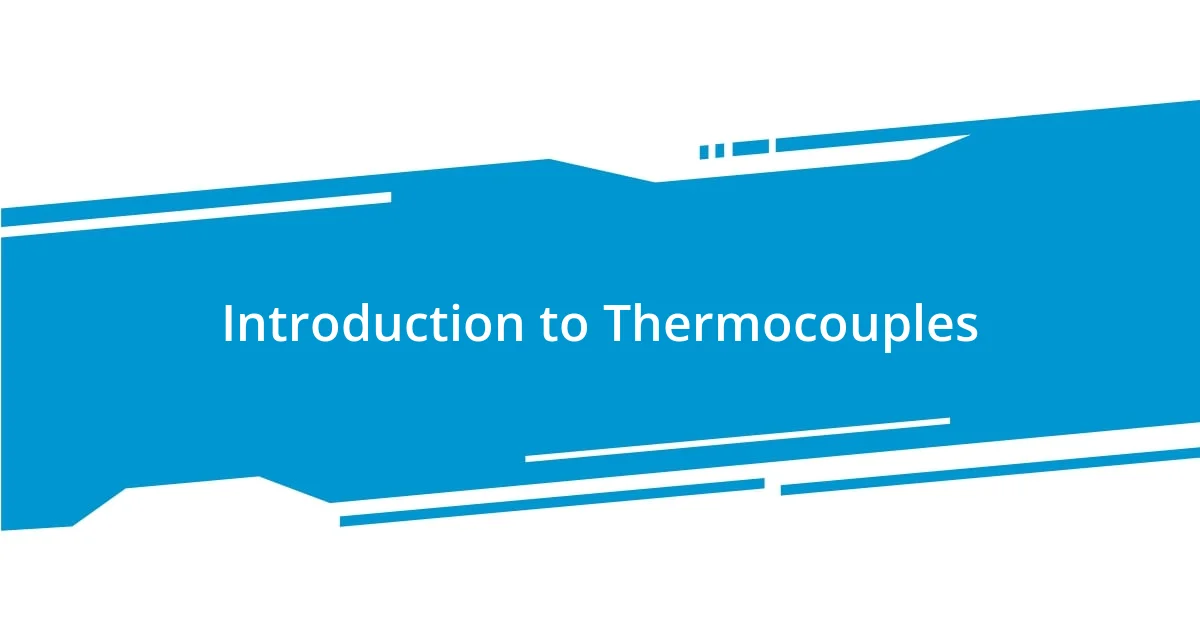
Introduction to Thermocouples
Thermocouples are fascinating devices, and in my experience, they embody a remarkable blend of simplicity and effectiveness. Made from two different metals joined at one end, they convert temperature differences into measurable voltage, allowing us to monitor heat in various industrial applications. I remember my first time using one; the precision in readings and how quickly they responded to temperature changes left me amazed.
What often strikes me is the versatility of thermocouples. Have you ever considered how crucial they are in industries ranging from manufacturing to food processing? I recall working on a project that involved temperature regulation in a large oven. The thermocouples helped ensure consistent baking results, highlighting just how pivotal they are to processes we often take for granted.
Thermocouples come in different types, each tailored to specific temperature ranges and environments. For instance, Type K thermocouples can handle higher temperatures, making them ideal for my experience in metal processing. It’s incredible how these small devices can withstand such extreme conditions while delivering reliable data, making them indispensable tools in our daily industrial activities.
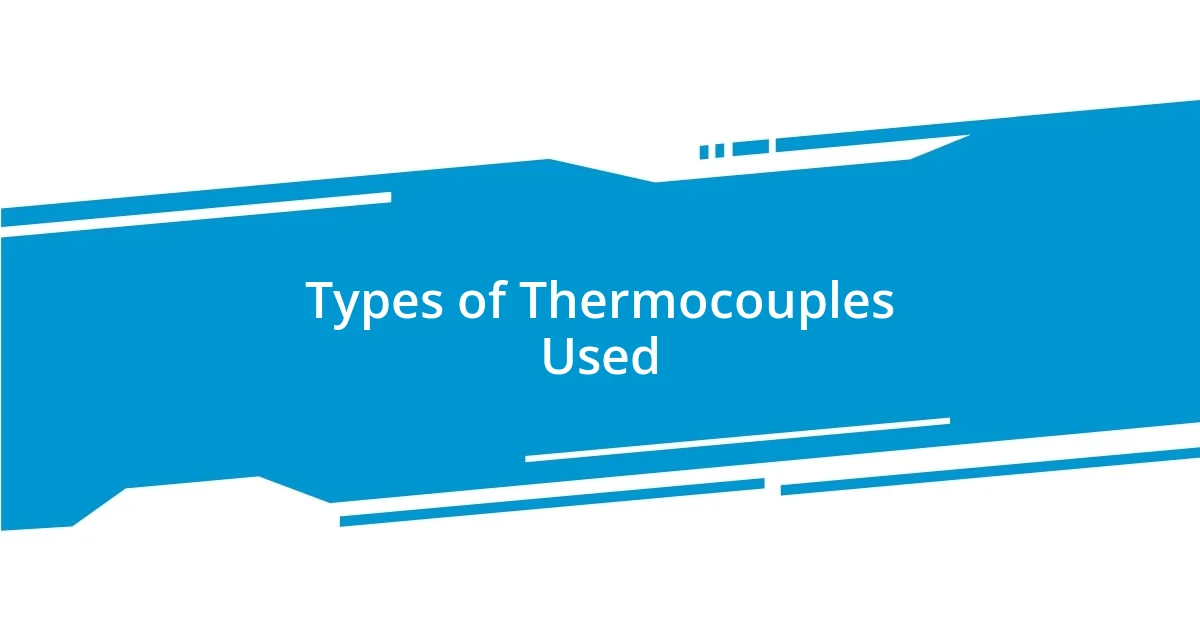
Types of Thermocouples Used
When I think about the various types of thermocouples I’ve encountered, I can’t help but appreciate how each one has its own unique benefits. For example, Type J thermocouples are often my go-to when I need a cost-effective solution with decent accuracy in moderately high temperatures. Their reliability has pleasantly surprised me on numerous occasions, particularly during my time working on a project involving HVAC systems, where quick, accurate temperature monitoring was essential.
Here are some key types of thermocouples frequently used in industry:
- Type K: Versatile and suitable for high temperatures up to 1,260°C; great for metal processing.
- Type J: Ideal for moderate temperatures (up to 750°C); often used in laboratory settings.
- Type T: Excellent for refrigeration applications; works well in lower temperatures (up to 350°C).
- Type E: Offers high output and works well in oxidizing environments; operates up to 900°C.
- Type N: Known for its stability and long-term reliability, particularly in high-temperature environments; operates up to 1,300°C.
Reflecting on my experiences, Type T thermocouples have always fascinated me, especially their behavior under chilled conditions. While setting up a refrigeration unit, I found their accuracy in low-temperature applications to be reassuring. Every time I checked those readings, it felt like they were silently ensuring the system’s efficiency, which is such a relief when dealing with sensitive materials. The personal connection I’ve formed with these little devices enhances my understanding of their pivotal role in various industrial processes.
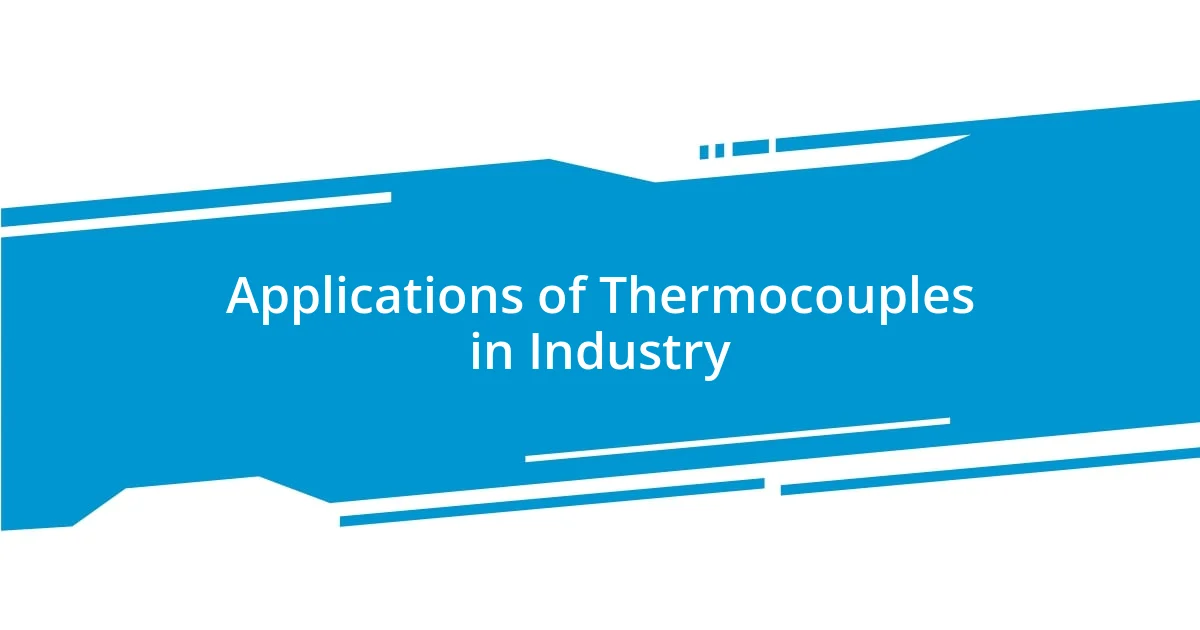
Applications of Thermocouples in Industry
Thermocouples find their way into diverse applications across various industries, proving their worth in real-time temperature monitoring. In my work with chemical processing, I vividly remember the critical role they played in maintaining reaction temperatures. A slight deviation could lead to undesirable results, and having thermocouples in place provided both accuracy and peace of mind. This experience taught me just how fundamental precise temperature control is for product quality and safety.
Interestingly, thermocouples are also essential in the food industry, where they ensure cooking temperatures are not just met, but maintained consistently. During a project in a large production kitchen, we relied heavily on thermocouples to verify that meats were cooked safely. The readings appeared almost instantly, allowing us to make immediate adjustments. It was incredibly satisfying to see how these small sensors could influence the overall efficiency and safety of food production.
Moreover, I’ve found thermocouples invaluable in the energy sector, especially in power plants. Monitoring the temperatures of various components can help prevent equipment failures. I recall an instance when we had to conduct routine maintenance; the thermocouples provided critical data that alerted us to a potential overheating issue. This real-world application highlights the indispensable nature of thermocouples and how they can protect valuable equipment from failure.
| Industry | Application of Thermocouples |
|---|---|
| Chemical Processing | Monitoring reaction temperatures for product safety and quality |
| Food Industry | Ensuring safe cooking temperatures in large production kitchens |
| Energy Sector | Monitoring equipment temperatures to prevent overheating and failures |
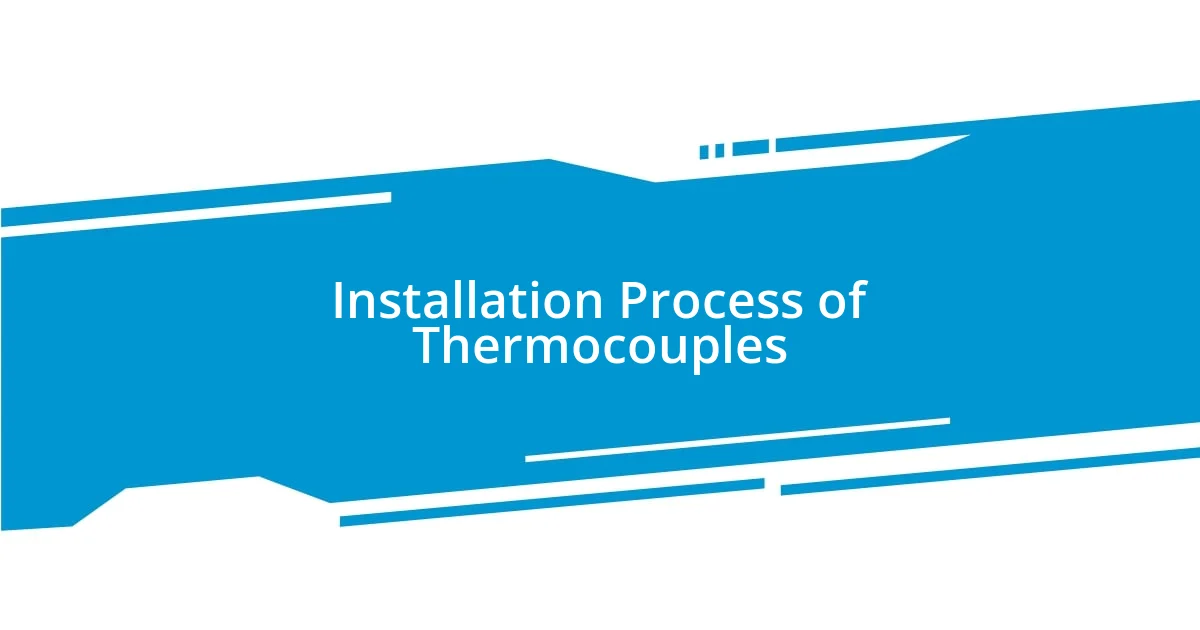
Installation Process of Thermocouples
When I think about the installation process of thermocouples, I remember the first time I had to do it myself. The preparation involved selecting the right type of thermocouple for the application, which can feel overwhelming, especially if you’re new to it. I often had to consult with my colleagues or reference manuals to ensure I wasn’t making a costly mistake.
As I began the actual installation, I noticed that positioning the thermocouple correctly was crucial. I learned to pay attention to proximity to the heat source and the direction of heat transfer. There was a moment during an installation on a furnace where I instinctively moved the sensor a few centimeters to avoid heat shield interference. That small adjustment dramatically improved the accuracy of our readings, a lesson I carry with me to this day.
One of the most memorable parts of installation is securing the wiring properly. It might sound trivial, but if wires are poorly placed or exposed, it can lead to erroneous readings or even safety hazards. I recall a project where we had to trace back a significant error to a loose connection that wasn’t secure during installation. It made me appreciate the importance of meticulousness in every step and reinforced my belief that thorough checking is essential for reliable performance. Have you ever faced a similar situation? It really emphasizes how every detail plays a role in achieving accuracy and safety in thermocouple applications.
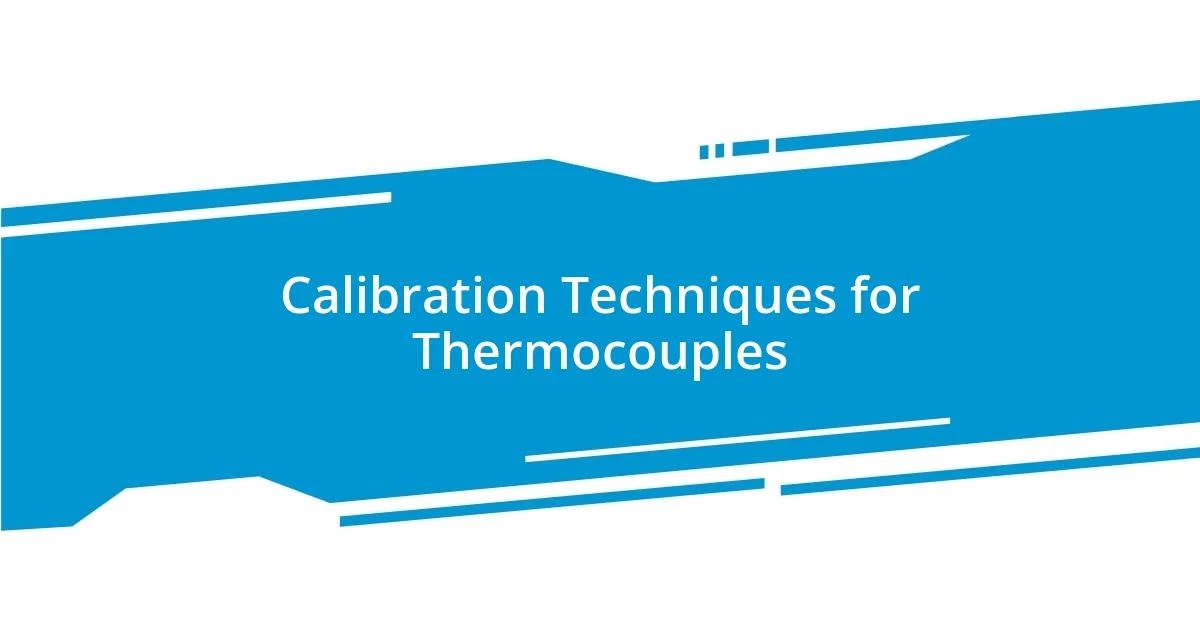
Calibration Techniques for Thermocouples
Calibration is a critical step in ensuring thermocouples deliver accurate measurements. In my experience, I’ve often used the ice bath method to calibrate these devices. By immersing the thermocouple in a mixture of ice and water at 0°C, it provides a reliable reference point. It’s surprising how much clarification this simple, yet effective technique can give. Have you ever calibrated in such a straightforward way? It was a game changer for me.
Another technique I’ve employed is the comparison method with a calibrated reference thermometer. I would place both the thermocouple and the reference thermometer in the same environment and monitor their readings. If they differed, I would adjust the thermocouple’s output accordingly. I remember once when this method revealed a shocking discrepancy in readings during a project. It emphasized the necessity of regular calibrations—there’s no room for complacency when it comes to precision.
I also found that using specialized calibration equipment, like temperature calibration baths, can yield incredibly precise results. I vividly recall a situation where using a calibration bath allowed me to zero in on the thermocouple’s accuracy for a critical process in the lab. It’s moments like these that solidify my understanding of the importance of calibration, ensuring that equipment operates within specified tolerances. Isn’t it fascinating how a small step like proper calibration can have such a profound impact on the overall process?

Common Troubleshooting Techniques
When troubleshooting thermocouple issues, the first thing I often check is the wiring. I remember a time when I encountered erratic readings during a critical production run; it turned out the wires had worn against a sharp edge. Ensuring that wires are properly insulated and secured can save you from a lot of head-scratching later on. Have you ever faced similar challenges? It’s those small, unnoticed details that can escalate into much larger problems.
I also pay close attention to the thermocouple’s calibration. There was an instance where my team was baffled by inconsistent temperature readings, and we eventually discovered that recent calibration hadn’t accounted for a drastic environmental change. This kind of oversight can lead to significant operational inefficiencies. Always recalibrating under current conditions is essential. Have you thought about how often environmental factors influence your readings?
Lastly, I find it invaluable to maintain good records of previous readings and calibrations. During one particularly chaotic project, I compared historical data and noticed a gradual drift in temperature readings. This insight not only guided us back to the correct calibration but also taught me the importance of data tracking for timely interventions. Keeping a log can be your best ally in identifying trends that highlight when something is going wrong. What strategies do you use to monitor the performance of your thermocouples? Sharing experiences can unveil a wealth of solutions and adjustments.
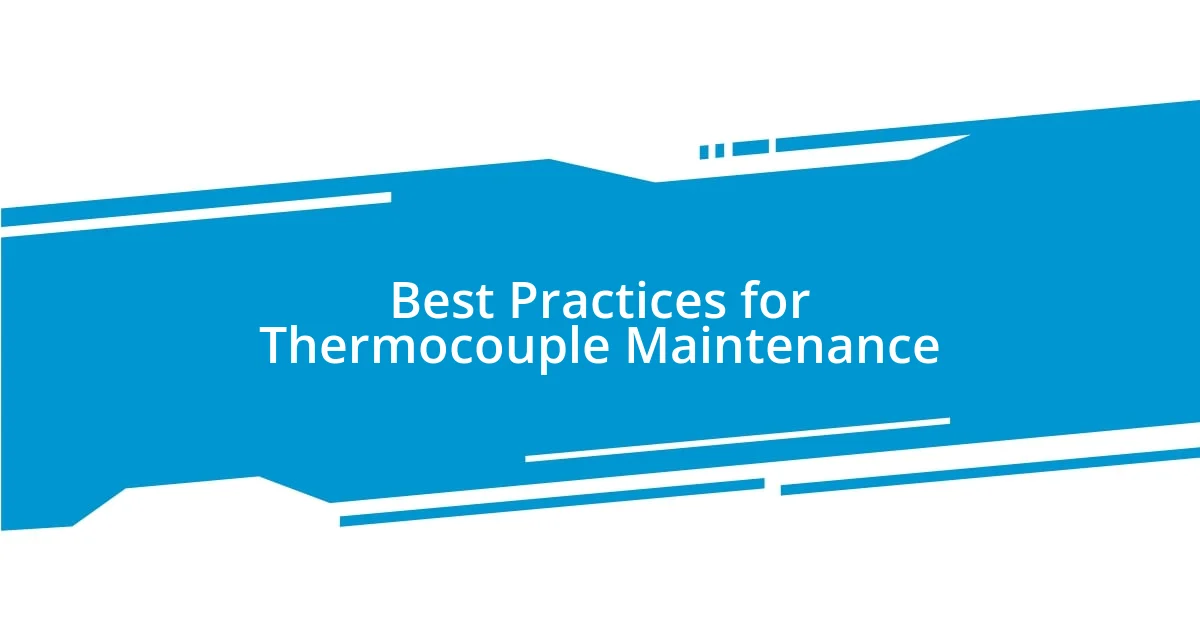
Best Practices for Thermocouple Maintenance
Maintaining thermocouples isn’t just about checking the readings; it’s also about creating a routine in your workflow. I’ve established a monthly inspection schedule where I not only check the calibration but also clean the thermocouples and their connections. During a plant overhaul, I once found a layer of dirt and grime building up on a sensor, which led to compromised readings. Have you experienced the same thing? Little things like maintenance have a huge impact on accuracy and reliability.
Another best practice that I’ve integrated is to ensure that thermocouples are protected from physical damage. I recall a project where a sensor was placed close to a frequently operated rack, and it got knocked multiple times. It’s surprising how a moment of carelessness can lead to persistent issues. I now advocate for protective shields and strategic placement during installation, making it part of our standard procedure. What protective measures do you consider essential in your setup?
Lastly, I often find that educating team members on the importance of thermocouple care is invaluable. Early in my career, I witnessed several coworkers dismissing minor discrepancies in readings as inconsequential. After one such instance resulted in a faulty batch, we held a workshop to refresh everyone on best practices and troubleshooting techniques. It was eye-opening—how does your team share knowledge about thermocouple maintenance? Creating a culture of awareness can truly enhance overall operational success.













